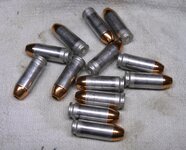
But I'm only going to do it once. Because there is only one reason I experimented with these once-fired aluminum cases. The 10mm Auto empty tends to get flung far away from the shooter, making recovery of the brass sometimes difficult. I will reserve these for times when I don't care where the "brass" goes.
I found about 60 of these on the ground when I went shooting near Darrington the other day. I didn't know CCI made aluminum case 10mm but then again, I never looked. Previously I've read all the words of wisdom about how you can't or shouldn't reload these. Nevertheless, I decided to experiment with these. Having some previous, successful experience loading unfired, pulled bullet .38 Special aluminum cases from RMR.
Reloading these presented absolutely no problems. I thought maybe I'd have to cement (using primer sealer) the 155 gr. Hornady XTP bullet in place in order to get sufficient bullet tension. That never happened. The resized cases held the seated bullet with a proper, substantial grip. My charge was at the low end using VV 3N37. They haven't been tried yet, but I don't see any issues coming up with them.












